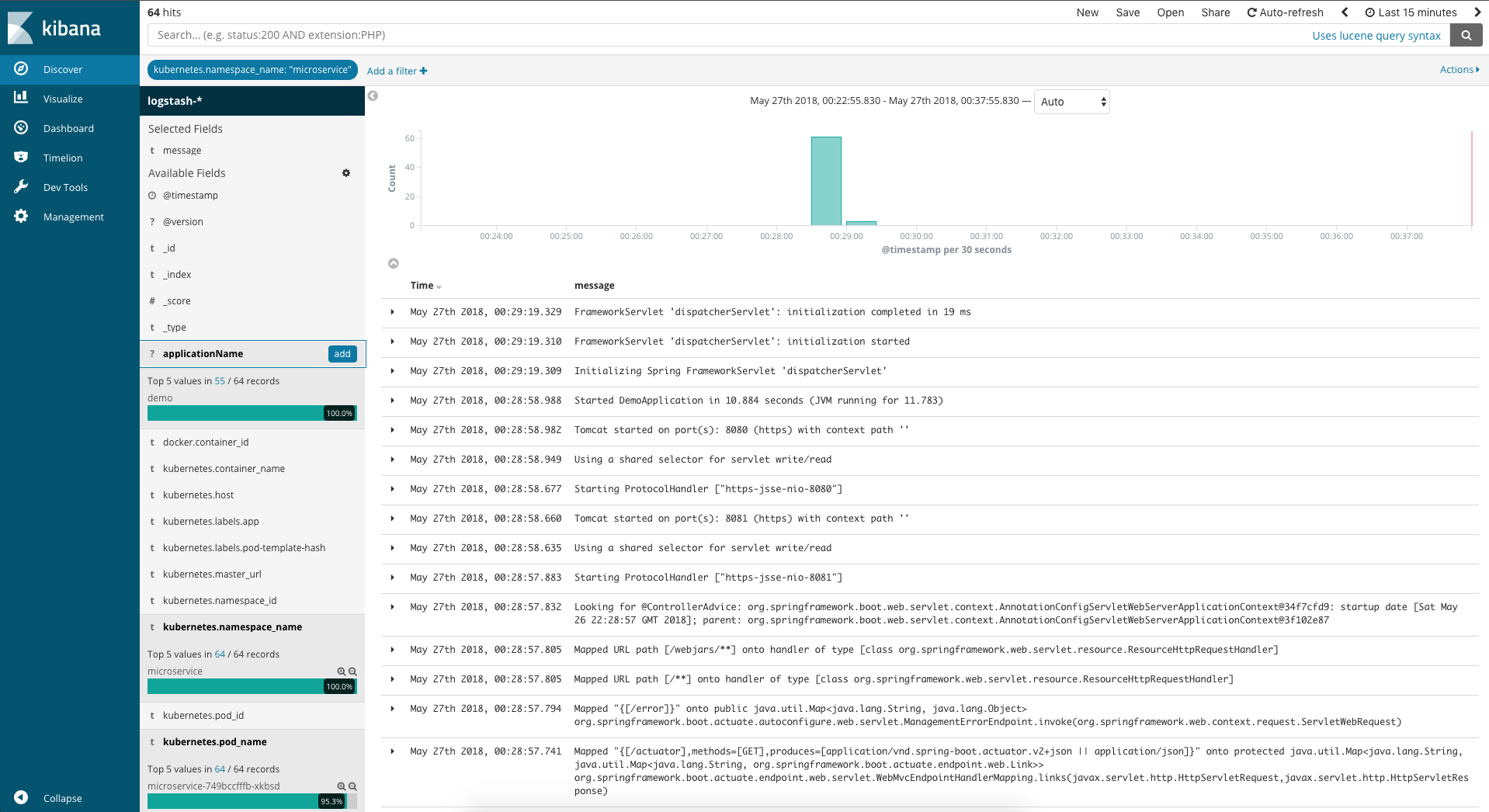Cloudify Spring Boot Application (Part III)
This blog post is a series of three posts.
- In the first of the posts I described how to Dockerize a Spring Boot application and run it in Kubernetes.
- The second part of the tutorial looks on how to monitor the application and see if everything is ok.
- And in this part of the series I’ll look on how to analyze and collect logs of the Spring Boot application.
The easiest part to export logs is to send them in JSON-Format to stdout. Then a tool called fluentd can scrape the logs and send them to Elasticsearch. Elasticsearch stores the metrics and makes them searchable. Together with Kibana a Dashboard for searching in Elasticsearch we can analyze and search through them.
Configure Spring Boot to send logs in JSON-Format
To configure Spring Boot to send JSON-Format to stdout is very easy. First we add the following dependency to our pom.xml file, this is required to get standard Encoder for JSON output to stdout:
<dependency>
<groupId>net.logstash.logback</groupId>
<artifactId>logstash-logback-encoder</artifactId>
<version>5.1</version>
</dependency>
After this we’ll add a logback-spring.xml file to our resources folder, this configures logback for JSON output:
<configuration>
<appender name="consoleAppender" class="ch.qos.logback.core.ConsoleAppender">
<encoder class="net.logstash.logback.encoder.LogstashEncoder"/>
</appender>
<logger name="jsonLogger" additivity="false" level="DEBUG">
<appender-ref ref="consoleAppender"/>
</logger>
<root level="INFO">
<appender-ref ref="consoleAppender"/>
</root>
</configuration>
If you now start the application you should see that the outputs are in JSON-Format:
{"@timestamp":"2018-06-12T14:54:34.586+02:00","@version":"1","message":"Starting ProtocolHandler [\"http-nio-8080\"]","logger_name":"org.apache.coyote.http11.Http11NioProtocol","thread_name":"main","level":"INFO","level_value":20000}
{"@timestamp":"2018-06-12T14:54:34.587+02:00","@version":"1","message":"Using a shared selector for servlet write/read","logger_name":"org.apache.tomcat.util.net.NioSelectorPool","thread_name":"main","level":"INFO","level_value":20000}
{"@timestamp":"2018-06-12T14:54:34.592+02:00","@version":"1","message":"Tomcat started on port(s): 8080 (http) with context path ''","logger_name":"org.springframework.boot.web.embedded.tomcat.TomcatWebServer","thread_name":"main","level":"INFO","level_value":20000}
{"@timestamp":"2018-06-12T14:54:34.598+02:00","@version":"1","message":"Started DemoApplication in 7.014 seconds (JVM running for 10.018)","logger_name":"de.koudingspawn.demo.DemoApplication","thread_name":"main","level":"INFO","level_value":20000}
Now everything is done in our application to make the logs readable by fluentd.
Setup fluentd
For how to setup fluentd please look at one of my last blog posts, there you can find a more detailed tutorial on how to setup monitoring with fluentd, kibana and elasticsearch.
Here is only a short version of fluentd setup:
---
apiVersion: v1
kind: ServiceAccount
metadata:
name: fluentd
namespace: logging
---
apiVersion: rbac.authorization.k8s.io/v1beta1
kind: ClusterRole
metadata:
name: fluentd
namespace: logging
rules:
- apiGroups:
- ""
resources:
- pods
- namespaces
verbs:
- get
- list
- watch
---
kind: ClusterRoleBinding
apiVersion: rbac.authorization.k8s.io/v1beta1
metadata:
name: fluentd
roleRef:
kind: ClusterRole
name: fluentd
apiGroup: rbac.authorization.k8s.io
subjects:
- kind: ServiceAccount
name: fluentd
namespace: logging
---
apiVersion: extensions/v1beta1
kind: DaemonSet
metadata:
name: fluentd
namespace: logging
labels:
k8s-app: fluentd-logging
version: v1
kubernetes.io/cluster-service: "true"
spec:
template:
metadata:
labels:
k8s-app: fluentd-logging
version: v1
kubernetes.io/cluster-service: "true"
spec:
serviceAccount: fluentd
serviceAccountName: fluentd
tolerations:
- key: node-role.kubernetes.io/master
effect: NoSchedule
containers:
- name: fluentd
image: fluent/fluentd-kubernetes-daemonset:elasticsearch
env:
- name: FLUENT_ELASTICSEARCH_HOST
value: "elasticsearch"
- name: FLUENT_ELASTICSEARCH_PORT
value: "9200"
- name: FLUENT_ELASTICSEARCH_SCHEME
value: "http"
resources:
limits:
memory: 200Mi
requests:
cpu: 100m
memory: 200Mi
volumeMounts:
- name: varlog
mountPath: /var/log
- name: varlibdockercontainers
mountPath: /var/lib/docker/containers
readOnly: true
terminationGracePeriodSeconds: 30
volumes:
- name: varlog
hostPath:
path: /var/log
- name: varlibdockercontainers
hostPath:
path: /var/lib/docker/containers
After you have redeployed the application with the changes for logging, you should see in Kibana the application logs:


